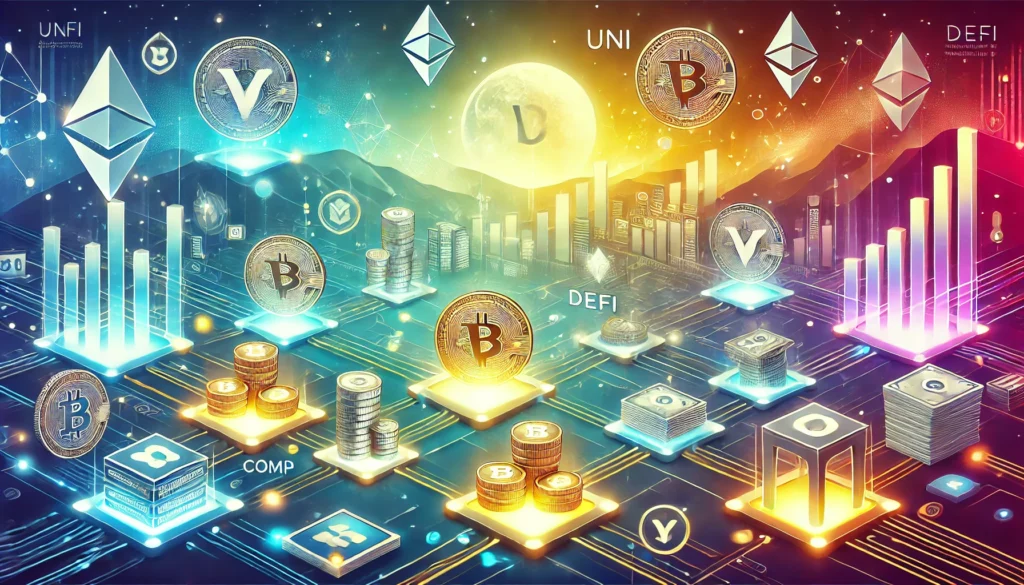The world of finance is evolving at a rapid pace, and one of the most exciting advancements in this space is the rise of Decentralized Finance (DeFi). At its core, DeFi is a movement that aims to recreate traditional financial systems—like lending, borrowing, trading, and insurance—using blockchain technology without the need for intermediaries like banks, brokers, or other centralized entities. By leveraging the power of smart contracts, DeFi is able to provide users with access to financial services that are more transparent, secure, and accessible.
As the DeFi ecosystem continues to grow, new coins and cryptocurrencies have become integral to its development. These new coins play a critical role in driving innovation within DeFi, enabling everything from yield farming and staking to liquidity provision and tokenized assets. The unique attributes of these new coins make them essential to the DeFi infrastructure, empowering users, developers, and investors alike to create a more inclusive and decentralized financial system.
This article delves into the role that new coins are playing in shaping the future of DeFi, the impact these coins are having on the financial landscape, and the challenges and opportunities that lie ahead for the DeFi ecosystem.
1. Understanding the DeFi Ecosystem and Its Growth
DeFi represents a significant departure from traditional finance, which has historically relied on centralized intermediaries to process transactions and manage financial systems. The key innovation of DeFi is the use of blockchain technology—particularly Ethereum—to facilitate peer-to-peer transactions and smart contracts. Smart contracts are self-executing agreements that automatically enforce the terms of a contract without the need for intermediaries, creating a more secure and transparent environment.
The DeFi ecosystem encompasses a wide variety of applications, including:
- Lending and Borrowing: Platforms like Compound and Aave allow users to lend their digital assets in exchange for interest or to borrow funds by providing collateral.
- Decentralized Exchanges (DEXs): Platforms like Uniswap and SushiSwap allow users to trade cryptocurrencies directly with one another, without the need for centralized exchanges, reducing fees and increasing privacy.
- Stablecoins: Cryptocurrencies like Dai and USDC provide price stability by being pegged to traditional assets like the US dollar, ensuring that users can avoid the volatility often associated with other cryptocurrencies.
- Yield Farming and Staking: By providing liquidity to platforms, users can earn rewards or interest on their holdings, creating additional avenues for investment.
- Insurance: DeFi projects like Nexus Mutual are working to decentralize insurance, allowing individuals to pool funds for coverage in a more transparent and open manner.
New coins are emerging to facilitate and power these platforms, offering unique advantages in terms of governance, reward mechanisms, and overall ecosystem support.
2. The Role of New Coins in DeFi
New coins are integral to the success and growth of DeFi, as they are used to facilitate transactions, reward participants, and enable governance. Here’s how new coins are driving DeFi’s innovation:
2.1 Incentivizing Participation and Liquidity
One of the primary roles of new coins in DeFi is to incentivize participation. In decentralized ecosystems, liquidity is essential for trading, lending, and borrowing to function smoothly. New coins often serve as rewards for users who provide liquidity to DeFi platforms. For example, users who deposit their assets into a lending platform like Compound are rewarded with COMP tokens, which give them voting power and governance rights within the platform.
This model encourages users to participate actively in the DeFi ecosystem, whether by providing liquidity to decentralized exchanges, lending their funds, or staking tokens to secure networks. The introduction of new coins has created an environment where users are financially incentivized to help grow and stabilize the ecosystem.
2.2 Governance and Decentralization
Many DeFi platforms issue governance tokens, which allow holders to participate in the decision-making process for the platform’s future. Governance tokens give users the ability to vote on proposals related to protocol changes, updates, or key business decisions, ensuring that the community has control over the direction of the platform.
For instance, the Uniswap (UNI) and SushiSwap (SUSHI) governance tokens enable their holders to vote on matters like fee structures, liquidity incentives, and how the platform’s funds should be allocated. The introduction of these governance tokens is crucial to DeFi’s ethos of decentralization, as it removes the need for a central authority or executive team to make decisions, instead empowering the community of users.
2.3 Tokenization and Asset Creation
DeFi platforms are creating new opportunities for the tokenization of assets. Tokenization refers to the process of representing ownership of real-world assets—like real estate, commodities, or even art—using digital tokens. These tokens can then be traded, borrowed against, or used in DeFi applications. New coins are the backbone of these tokenized assets, providing liquidity and enabling transactions in these emerging markets.
Platforms like Synthetix allow users to trade synthetic assets that mirror the value of traditional assets, such as stocks, commodities, or fiat currencies, while others, like RealT, enable the tokenization of real estate for fractional ownership. New coins help facilitate these innovations by providing liquidity, establishing ownership, and allowing secure trading of tokenized assets.
3. Trends Shaping the Future of DeFi and New Coins
The DeFi landscape is evolving rapidly, and several trends suggest where the space is headed. These trends, along with the emergence of new coins, will continue to drive the evolution of decentralized finance.
3.1 Increased Integration with Traditional Finance
One of the major trends in DeFi is its growing integration with traditional finance. As DeFi platforms gain traction, many traditional financial institutions are exploring ways to integrate blockchain-based solutions with their existing systems. New coins may be used as a bridge between the decentralized and traditional financial systems, offering stability and interoperability.
The introduction of Central Bank Digital Currencies (CBDCs) may also spur the development of new coins in the DeFi space, allowing for more seamless interactions between central banks and decentralized networks.
3.2 Cross-Chain Interoperability
DeFi has largely been confined to Ethereum and its associated networks, but the future of DeFi lies in cross-chain interoperability. New coins are being developed on other blockchains, such as Polkadot, Binance Smart Chain, and Avalanche, which allow different DeFi platforms to interact with one another, improving liquidity and expanding opportunities for users. Cross-chain interoperability will make it easier for assets and data to move freely between different platforms, helping to scale DeFi.
3.3 Sustainability and Green DeFi
As DeFi continues to grow, there is an increasing focus on the environmental impact of blockchain transactions. Many DeFi platforms run on Proof of Work (PoW) systems, which are energy-intensive. To address this, new coins and platforms are exploring more energy-efficient consensus mechanisms, such as Proof of Stake (PoS). By adopting greener technologies, DeFi can reduce its environmental footprint while continuing to provide decentralized financial services.
4. Risks and Challenges for New Coins in DeFi
While DeFi presents enormous potential, it is not without risks and challenges. Some of the key concerns include:
4.1 Regulatory Uncertainty
DeFi operates in a relatively gray area with regard to regulation. Governments around the world are beginning to scrutinize decentralized platforms, especially in relation to money laundering, fraud, and tax evasion. As regulations evolve, new coins in the DeFi space may face legal challenges that could affect their adoption and use.
4.2 Security Risks
The rapid growth of DeFi has attracted cybercriminals seeking to exploit vulnerabilities in smart contracts or decentralized applications (dApps). High-profile hacks and exploits have highlighted the risks associated with DeFi protocols. Ensuring the security of smart contracts and auditing code will be essential to mitigate these risks.
4.3 Scalability Issues
As more users flock to DeFi platforms, scalability remains a challenge. High gas fees on networks like Ethereum during times of congestion can make DeFi transactions prohibitively expensive. While newer coins and Layer 2 solutions are addressing this issue, achieving widespread scalability will be a critical step for DeFi’s long-term success.
5. Conclusion
The rise of new coins in the DeFi ecosystem is reshaping the financial landscape, driving innovation and offering exciting opportunities for users, developers, and investors. By removing intermediaries, increasing transparency, and incentivizing participation, these coins are making DeFi more accessible and efficient than ever before. As the DeFi space matures, we can expect more integrations with traditional finance, cross-chain interoperability, and sustainable, green solutions.
While challenges remain, the future of DeFi is bright. The continued development of new coins and technologies will play a pivotal role in pushing DeFi to new heights, ultimately creating a more decentralized, inclusive, and accessible financial system for people around the world.


